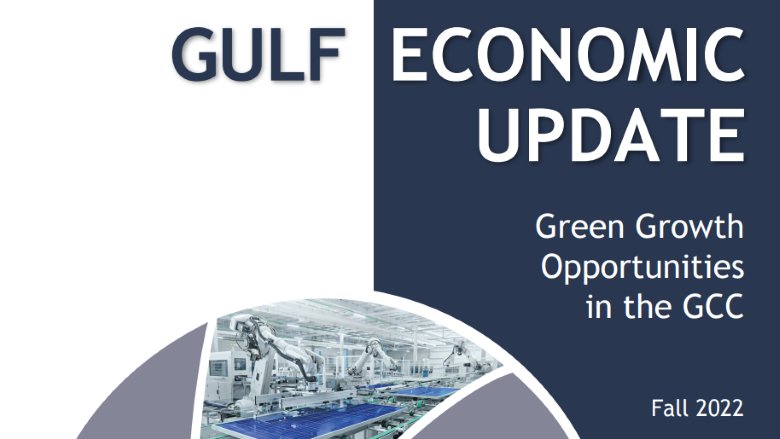This issue of the Gulf Economic Update includes a special section focused on GCC green growth opportunities for the GCC countries as the world accelerates transition to a greener future. Moving away from fossil fuels towards greener energy should not be seen as a threat but as a tremendous opportunity. This direction is entirely in line with GCC country vision documents that outline an image of the economy of the future that relies increasingly on the private sector playing a leading role in investment, job creation and value addition. The report presents the latest economic developments in the GCC focusing on the post-pandemic recovery, the vaccine roll out and the implications of a more favorable oil market. The team will highlight the medium-term prospects given continued volatility in the oil market and the need to diversify GCC economies.
GCC Countries Outlook
Bahrain: Bahrain’s economic outlook hangs on oil market prospects and the government’s commitment to the reform agenda. Growth is expected to accelerate to 3.8% in 2022; mainly driven by the non-hydrocarbon sector which is expected to exceed 4% growth, supported by the full reopening of the economy and a stronger manufacturing sector. Higher oil prices and resuming spending restraints under FBP are expected to significantly narrow the fiscal deficit to less than 4% of GDP in 2022. The current account balance, which recorded its first surplus in seven years in 2021, is forecasted to improve markedly to reach 11.3% of GDP in 2022 and remain in surplus over the medium term.
Kuwait: Economic growth is forecast to accelerate in 2022 to 8.5% before moderating to 2.5% in 2023 and 2024, respectively. The non-oil sector is anticipated to continue expanding in 2023 following a 7.7% uptick in 2022. More robust demand will be translated into additional upward inflationary pressures, though monetary tightening and decreasing global food prices will moderate inflation in the medium term. The fiscal balance is anticipated to register a surplus of 1.1% of GDP in 2022, with the possibility of a widening surplus (5.9% of GDP) if the newly elected Parliament approves government’s proposal to suspend FGF transfer during this fiscal year. Higher oil receipts are expected to more than compensate for the larger imports bill resulting in a significant external balance surplus of 28.6% of GDP in 2022.
Oman: The economy is projected to continue its recovery and strengthen over the medium-term, driven by robust energy prices, expansion of oil and gas production, and wide-ranging structural reforms. GDP growth is forecast to reach 4.5% in 2022 before moderating to an average of 3.2% in 2023-24. The overall fiscal deficit is expected to turn into a surplus of nearly 6% of GDP in 2022—the first surplus in almost a decade—reducing gross financing needs. Similarly, the external balance is swinging back into surplus (6% of GDP in 2022)—the first surplus in 7 years—on the back of higher oil receipts and recovery in non-oil exports.
Qatar: Real GDP is estimated to rise to 4% in 2022 with exports (5.4%) and government consumption (4.8%) leading on the demand side. Growth in private consumption may be slightly below 4.5%, driven by higher interest rates and prices. Consumer prices are projected to increase on average 4.6% this year and to remain a full percentage point above levels recorded last year as far out as 2024. Both the current account and fiscal balance surpluses are projected to widen significantly in 2022 given their dependence on booming hydrocarbon prices—with the former expected to reach 20% of GDP and the latter 6% of GDP during 2022.
Saudi Arabia: Growth is expected to accelerate to 8.3% in 2022 before moderating to 3.7% and 2.3% in 2023 and 2024, respectively. In spite of recent signals for a more cautious approach to OPEC+ planned production, the oil sector will remain the main driver behind this growth with output estimated to grow by 15.5% in 2022. The budget balance should register a surplus of 6.8% of GDP in 2022—the first surplus in nine years—driven by higher oil revenues. Meanwhile, higher oil receipts are expected to more than compensate for the larger imports bill resulting in a significant external balance surplus of 18.8% of GDP in 2022.
United Arab Emirates: Higher oil export volumes coupled with a revival in non-oil demand will support strong economic growth in 2022. This is further supported by a favorable business environment and world-class infrastructure. Real GDP is expected to grow by 5.9% in 2022 before moderating to 4.1% in 2023 as slower global demand dampens growth due to tightening financial conditions. Higher oil receipts supplemented with a gradual non-oil recovery will bolster fiscal revenue resulting in a fiscal surplus to hover around 4.4% of GDP in 2022. Recent bilateral free trade agreements with Asian partners supported by strong oil exports will place the current account surplus at 11.2% of GDP in 2022.
This issue of the Gulf Economic Update includes a special section focused on GCC green growth opportunities for the GCC countries as the world accelerates transition to a greener future. Moving away from fossil fuels towards greener energy should not be seen as a threat but as a tremendous opportunity. This direction is entirely in line with GCC country vision documents that outline an image of the economy of the future that relies increasingly on the private sector playing a leading role in investment, job creation and value addition. The report presents the latest economic developments in the GCC focusing on the post-pandemic recovery, the vaccine roll out and the implications of a more favorable oil market. The team will highlight the medium-term prospects given continued volatility in the oil market and the need to diversify GCC economies.
